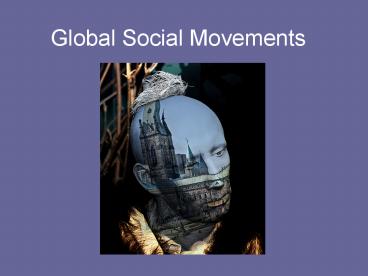Global Social Movements PowerPoint PPT Presentation
1 / 22
Title: Global Social Movements
1
Global Social Movements
2
Week 3. Social Movements and the Making of
Modern Politics Nation, State, Capitalism.
3
Outline
- I. Introduction What Are Old Movements?
- II. Nationalist Movements Making the
Nation-State - III. Capitalism and the Making of Liberal
Democracy - IV. The Self-Making of the Working Class
- V. Politics of the Working Class I
Revolutionary Socialism - VI. Politics of the Working Class II. Social
Democracy
4
I. Introduction What Are Old Movements?
- 1. Aim to look at some central features of
nationalist, liberal and socialist movements as
movements. - 2. Consider features of the movement
- (i) aims and ideology.
- (ii) forms of organisation,
- (iii) tactics and forms of political practice,
- (iv) achievements and failures contribution to
context of contemporary politics
5
- 3. I.e. Nationalism, liberalism and socialism as
formative contexts of modern states. - 4. Making sense of the distinction between old
and new social movements.
6
II. Nationalist Movements Making the
Nation-State
7
- 1. Nationalism and the formation of the modern
nation-state system. - 2. Nationalist movements seek to align
- state sovereignty
- Nation
- i.e. imagined national community (B. Anderson)
- 3. Distinguish between movements of
- national expansion
- self-determination.
8
- 4. Nationality as usually
- exclusive identity
- overrides class, religion etc.
- 5. Political practice of nationalism
- (i) strong state/ state-centred politics
- (ii) hierarchical organisations
- (iii) war and violence
- (iv) language and culture
- 6. Are nationalist movements old?
- 7. The continuing place of nationalism in a
globalising world?
9
III. Capitalism and the Making of Liberal
Democracy -
10
- 1. Historical contexts for emergence of
liberalism - (i) rise of capitalism
- (ii) Protestantism and religious conflict
- 2. Liberalism as ideology
- agents traders, capitalists and middling
classes - mainly Protestant
- i.e. as expression of a social movement
11
- 3. Liberal freedom as religious tolerance
- (i) individualism against religious state
- (ii) pragmatic solution to religious conflict
- (iii) i.e. product of religious social movements
- 4. Liberal freedom as economic
- (i) freedom from taxation
- (ii) market freedom and laisser faire
- (iii) invisible hand of the market (A. Smith)
- (iv) free trade and cf. globalisation/
neoliberalism
12
- 5. Limitations of liberal freedom
- (i) no social justice
- (ii) abstract, so initially for (heterosexual)
white male owners of property - 6. Liberalism allows freedom without democracy.
- 7. Democracy as achievement of
- working class
- womens social movements.
13
IV. The Self-Making of the Working Class
14
- 1. Self-making of the working class (18th-19th
centuries) - E. P. Thompson, The Making of the English Working
Class - class identity and solidarity
- vs. parochial, ethnic and national identities
- 2. The working-class cultural revolution
- (i) education
- (ii) dignity of labour
- (iii) right to suffrage/ vote/ political rights
- (iv) material equality and social justice
15
- 3. Political practice of working-class social
movement - (i) trade union movement
- (ii) Chartist movement for democratic rights
- (iii) socialist communities (e.g. Robert Owen)
- (iv) mutual help, cooperatives
- (v) revolutionary and reformist socialism (see
below).
16
V. Politics of the Working Class I Revolutionary
Socialism
17
- 1. Socialist revolution as only solution to
problems of capitalism. - 2. Leninist path to revolution in Russia
- militant party
- seizure of state power
- democratic centralism
18
- 3. Problems of revolutionary communism
- (i) non-occurrence of revolution in West
- (ii) failed revolutions in East
- (iii) collapse of communism (except Cuba and N.
Korea) - (iv) China socialism with Chinese
characteristics
19
VI. Politics of the Working Class II. Social
Democracy
20
- 1. Sources of social democracy
- (i) trade union movement
- (ii) revisionist Marxism (E. Bernstein)
- (iii) social liberalism (T. H. Green)
- 2. Political practice
- (i) electoral parties e.g. ALP
- (ii) gradual path to socialism through reforms
21
- 3. Achievements of social democracy
- (i) welfare state
- (ii) reduced social inequalities
- (iii) workers rights
- 4. Limitations of social democracy
- (i) problems of the welfare state - bureaucracy
and paternalism - (ii) decline of working-class social movement
- (iii) neoliberalism and globalisation
22
Summary
- I. Introduction What Are Old Movements?
- II. Nationalist Movements Making the
Nation-State - III. Capitalism and the Making of Liberal
Democracy - IV. The Self-Making of the Working Class
- V. Politics of the Working Class I
Revolutionary Socialism - VI. Politics of the Working Class II. Social
Democracy

